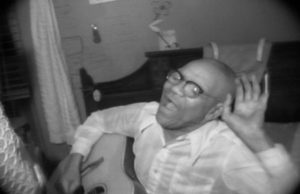This Saturday, we present William Eggleston’s Stranded in Canton. Since the 1970s, Eggleston has had a deep and singular influence on American photography. His best-known images – there are many – are unmistakably his own. Rich and barren in a particularly striking way, they’re populated by objects that are often described as “ordinary.” But they also capture a singular sense of place and time that has come to be strongly associated with the South, especially Memphis and New Orleans, and with Eggleston himself. *
One of Eggleston’s early photographic innovations involved his use of color photography and printing. Instead of hewing to the black-and-white grit and shadow of Robert Frank (an early influence), Eggleston introduced vivid colors that contrasted powerfully with his subject matter, sometimes complementing it and often complicating it.
But in the mid-Seventies, Eggleston also experimented with the nascent medium of portable video, traveling widely with a Sony Portapak and recording his encounters. The highly influential Portapak was the first portable analog video recording system, basically a proto-camcorder. Video had previously been a cumbersome, fragile, and largely stationary medium, used mainly for telecine transfers from film for broadcast, and in the art world, where its durationality and visual flaws were fascinating. Well-known artists like Andy Warhol (Outer and Inner Space, 1966) and Frank Zappa (200 Motels, 1971) recorded on video that was transferred back to film.
The Portapak doesn’t provide great quality, being made up of 300-plus horizontal lines of analog video. (For an indirect comparison, HD video has 1,080 horizontal rows of pixels and perhaps five times the vertical width.) But the immediacy of video immediately exploded the type, amount, and quality of media-making. Video collectives sprouted up, like Videofreex and Raindance (both 1969), and our own beloved New Orleans Video Access Center (NOVAC, 1972). But the Portapak, along with the many, many ensuing products and formats following it, made analog video into something that could be done practically anywhere, not just in a television studio. Publications like Radical Software reflected the idea that new communities and networks were developing to increase access to media-making through the use of portable video technology.
Eggleston, on the other hand, filmed seemingly outside these social groups, consistent with his photographic practice. Instead, he traveled around and shot in New Orleans, Memphis, and other locales, compiling what has been estimated at 30 or so hours of footage that wasn’t edited and released until 2005. The finished film, credited to co-directors Eggleston and Robert Gordon (Best of Enemies), is a fascinating compliment to Eggleston’s photography of the period and a disturbing, complex portrait of a world that still feels misty, dangerous, and mostly hidden.
Stranded in Canton is made up largely of casual, impromptu nighttime performance. Subjects – many personal friends and acquaintances of Eggleston himself – are hanging out for indeterminate reasons, pontificating and mugging for the camera, drinking and taking drugs, and the like. The desaturated, ghostly video image, captured in infrared according to some sources, is an inversion of Eggleston’s use of color and precise photographic printing. Instead, a precise sense of atmosphere is conveyed through the imperfection, haze, and tight framing of the video image.
Stranded in Canton captures the thing that strikes me most in Eggleston’s work: an uncanny mixture of yearning and disappointment, danger and boredom that, as a Southern transplant who feels like an outside observer, I personally feel and see. The film’s subjects are raw and intimate, performing actions that border on nihilistic. They have abandoned hope, but want to be taken seriously, or at least paid attention to; they suppress the struggle to face up to or discard ambitions. In slower moments, the viewer’s mind wanders: what are they like in the daytime? What is it that keeps these people from themselves? What keeps us from ourselves?
The film is meandering and dreamlike, punctuated by the occasional brilliant or harrowing moment that drifts by with little drama. Throughout, subjects address the camera, speaking harmlessly on big ideas and big thoughts. But nothing of consequence happens. The camera’s passivity plays on their desire, spoken or not, for recognition. – TB
* Some of Eggleston’s photographs are on display at the Ogden Museum of Southern Art through October 26, 2017.




